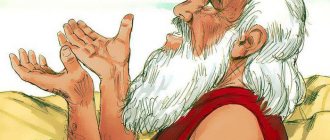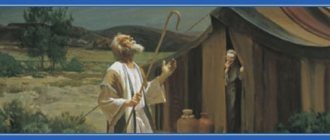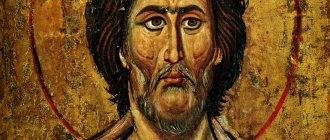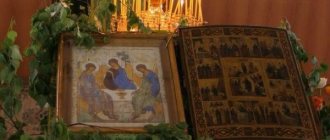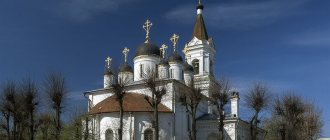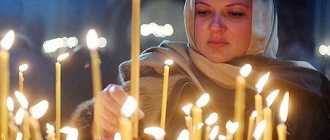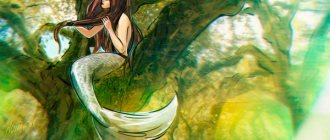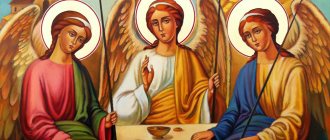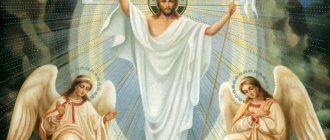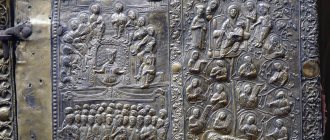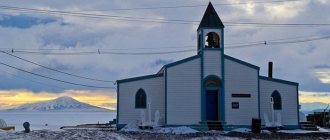Sharing Faith - Through Love
Archpriest Alexander Saltykov, Dean of the Faculty of Church Arts, Associate Professor of the Department of History and Theory of Christian Art at PSTGU:
“The words “by looking at the Holy Trinity overcomes the fear of the hated discord of this world” are attributed to St. Sergius of Radonezh. What is the Reverend talking about?
- During the life of Rev. Sergius's princes were at enmity with each other, despite the fact that they were all oppressed by the Mongol-Tatars. They could not unite, although, note, they were all relatives, from the same Rurik family. Moreover, they themselves invited the Mongol-Tatars to Rus' to plunder Russian cities, using them in their internecine struggle.
When you are surrounded by uncertainty, general hostility, when it is not clear who to rely on, then fear takes over a person.
There is no single law, there is no single authority, everything is against everyone... Therefore, St. Sergius speaks of “the fear of discord in this world.”
The words of St. Sergius relate to the teaching of the Church about the veneration of God, the One in three Persons, as the unity of love - this is the teaching revealed to us by the Lord Jesus Christ in the Gospel. The Church has always prayed and prays in all Divine services to the Holy Trinity.
But in ancient times, the veneration of the Most Holy Trinity was concentrated in other holidays - first of all, the Epiphany and the Transfiguration of the Lord - this is a remembrance of the appearance of the Holy Trinity. Pentecost is the Day of the Descent of the Holy Spirit on the Apostles.
Monasteries and churches in the name of the Most Holy Trinity were built very rarely. The Monk Sergius created the monastery of the Most Holy Trinity and showed us that, wishing to comprehend the teaching of love, we must begin with the veneration of the Holy Trinity, cognizable through the only Son of God from the Trinity - the Lord Jesus Christ.
The emphasis on the Trinity turned out to be extremely important and necessary for the Russian Church and our people at that difficult time. And this experience revealed that salvation, overcoming fear, is achieved through love, and through love we share our faith with others.
Icon of St. Andrey Rublev is a surprisingly harmonious response to a spiritual step in the consciousness of the people. She became not only a Russian, but also a worldwide symbol of the Trinity of the Divine.
Even in Protestant churches, where icons are not revered, but are perceived as some kind of symbols, emblems, one can find reproductions of Rublev’s “Trinity”. Of course, this is a gracious image inspired by the Holy Spirit.
"Temple Painting" Reproduction of a miniature from the manuscript “The Life of Sergius of Radonezh” from the late 16th century.
— How does the time in which he paints icons affect the icon painter?
— All people pray differently at different times. When we pray little, the Lord sends trials. All kinds of experiences affect everyone, including icon painters.
Now there is an epidemic, and I know that many have begun to pray more.
In the rite of consecration of the icon there is a request that the Lord give healing power to the consecrated image, so that people through it receive God's help. So doesn’t the Lord really act through his slaves, icon painters, and give them special power? We are talking about real icon painters who pray.
Like everyone else, when it’s difficult for us, we pray more and the Lord helps us more.
- Venerable Joseph Volotsky wrote that Andrei Rublev and Daniil Cherny “contemplated the icons.” How does this relate to the fact that you should not imagine images during prayer?
— Contemplation does not mean fantasizing, imagining images that do not exist. Here I am standing on the bank of the river - the Volga is in front of me. I contemplate it and enjoy it. We also look at pictures, listen to music, read poetry, immersing ourselves in them.
Unfortunately, we have lost this skill - immersion in art. You need to learn to contemplate, and not just absorb information about paintings, or run around the halls of the museum with notebooks.
Every high-level painting is created specifically for contemplation. Moreover, religious images are intended for contemplation.
The task of the icon painter is special - he depicts the Eternal, the non-evening Light, and is called upon to awaken the feeling of Eternity in the audience.
St. Joseph says that the Monk Andrew himself spent his whole life learning to know the Lord through the spiritual beauty of the true image.
God the Trinity - God of mutual love
History of the icon in the 20th century
Walter Benjamin, who visited Russia in 1926, wrote about him: “...and the neck and arms, when the frame covers the icon, appear as if in massive chains, so that the angels are somewhat reminiscent of Chinese criminals sentenced for their atrocities to stay in metal stocks.” .
Background to the clearing
At the turn of the 19th and 20th centuries, Russian icon painting as an art was “discovered” by representatives of Russian culture, who discovered that the quality of this artistic movement was not inferior to the best world movements. The icons began to be removed from their frames, which covered them almost completely (with the exception of the so-called “personal letter” - faces and hands), and also to be cleared. Cleaning was necessary, since icons were traditionally covered with drying oil. “The average period for complete darkening of drying oil or oil-resin varnish ranges from 30 to 90 years. On top of the darkened covering layer, Russian icon painters painted a new image, as a rule, matching the plot, but in accordance with the new aesthetic requirements imposed by time. In some cases, the restorer strictly followed the proportions and principles of compositional structure of the original source, in others he repeated the plot, making amendments to the original image: he changed the sizes and proportions of the figures, their poses, and other details” - the so-called renovation of icons.
Trinity Updates
The Trinity has been renewed four or five times since at least 1600:
- Its first renovation dates back, apparently, to Godunov.
- Next, most likely, by 1635, when all the monumental painting and iconostasis of the Trinity-Sergius Lavra were renewed, and taking into account the nature of the renovations of monumental painting, we can assume that it was at this time that the “Trinity” icon was barbarously sanded and those losses of colorful The layers we have today - for example, on the clothes of the angels and on the background - are the result of this renewal.
- Then it was renewed in 1777 under Metropolitan Plato during the same alteration of the Trinity iconostasis
- Then twice, according to information provided by Guryanov, in the 19th century: in 1835 and in 1854-55 - by the Paleshans, as well as by the artist I. M. Malyshev.
Clearing of 1904
At the beginning of the 20th century, icons were cleared one after another, and many of them turned out to be masterpieces that delighted researchers. Interest also arose in the “Trinity” from the Lavra. Although, unlike, for example, the Vladimir or Kazan icons, it did not enjoy colossal veneration among believers, did not perform miracles - it was not “miraculous”, did not stream myrrh and did not become the source of a large number of lists, nevertheless, it enjoyed a certain reputation - mainly , due to the fact that they believed that this image was the same one that “Stoglav” pointed to, since no other “Trinities” ordered by Rublev were known. It is important to mention that, due to its mention in Stoglav, the name of Rublev as an icon painter (as if his “canonization” as an artist) was highly revered among believers, and therefore many icons were attributed to him. “The study of the Trinity could provide art historians with a kind of reliable standard, by reference to which it would be possible to obtain a comprehensive understanding of the style and working methods of the famous master. At the same time, this data would make it possible to carry out an examination of other icons that were attributed to Andrei Rublev on the basis of legend or popular opinion.”
At the invitation of the father-vicar of the Trinity-Sergius Lavra, in the spring of 1904, the icon painter and restorer V.P. Guryanov took the icon out of the iconostasis, removed the gold chased frame from it, and then for the first time freed the “Trinity” icon from later records and blackened drying oil. Guryanov was invited on the advice of collector I. S. Ostroukhov, the restorer was assisted by V. A. Tyulin and A. I. Izraztsov.
As it turned out, the last time the “Trinity” was updated (that is, “restored” according to the concepts of ancient icon painters, recording again) was in the middle of the 19th century. When removing the frame from it, Guryanov saw, of course, not Rublev’s painting, but a continuous record of the 19th century, under it there was a layer of the 18th century from the time of Metropolitan Plato, and the rest, perhaps some fragments of other times. And already under all this lay Rublev’s painting.
| When the golden robe was removed from this icon,” writes Guryanov, “we saw an icon completely written down... On it the background and margins were sankir, brown, and the gold inscriptions were new. All the angels' clothes were rewritten in a lilac tone and whitewashed not with paint, but with gold; the table, the mountain and the chambers were rewritten again... Only the faces remained, by which one could judge that this icon was ancient, but they were also shaded in the shadows with brown oil paint. |
When V.P. Guryanov, having removed three layers of strata, the last of which was made in the Palekh manner, discovered the author’s layer (as it turned out during the repeated restoration in 1919, in some places he did not reach it), both the restorer himself and eyewitnesses to his discovery experienced a real shock. Instead of the dark, “smoky” tones of the dark olive swirl of faces and the restrained, severe brown-red range of clothes, so familiar to the eye of a connoisseur of ancient Russian icon painting of that time, bright sunny colors, transparent, truly “heavenly” clothes of angels, immediately reminiscent of Italian ones, were revealed to the amazed spectators frescoes and icons of the 14th century, especially the first half of the 15th century.
Having removed the layers of late painting, Guryanov recorded the icon anew in accordance with his own ideas about what this icon should look like (the restorers of the Silver Age were still very archaic). After this, the icon was returned to the iconostasis.
Researchers write about the clearing and restoration of Guryanov, which later had to be liquidated: “Actually, restoration in the modern scientific understanding of the word can be called (but not without some reservations) only the opening of the monument, carried out in 1918; all previous work on “Trinity”, in fact, were only its “renewals,” not excluding the “restoration” that took place in 1904-1905 under the leadership of V.P. Guryanov. (...) There is no doubt that the restorers of the icon deliberately strengthened, in fact, its entire graphic-linear structure - with a rough forcing of the contours of figures, clothes, halos, and even with obvious interference in the “holy of holies” - in the area “ personal letter,” where the author’s incomplete and probably poorly preserved “inventory” of faces and “drawing” of their features (already quite schematically reproduced by later renovations of the 16th–19th centuries) were literally dented and absorbed by the rigid graphics of V.P. Guryanov and his assistants."
Clearing of 1918
As soon as the icon got back into the iconostasis of the Trinity Cathedral, it quickly darkened again and had to be opened again. In 1918, under the leadership of Count Yuri Olsufiev, a new restoration of the icon began. This disclosure was started on the initiative and carried out on the instructions of the Commission for the Discovery of Ancient Painting in Russia, which included such prominent figures of national culture as I. E. Grabar, A. I. Anisimov, A. V. Grishchenko, K. K Romanov, and the Commission for the Protection of Art Monuments of the Trinity-Sergius Lavra (Yu. A. Olsufiev, P. A. Florensky, P. N. Kapterev). Restoration work was carried out from November 28, 1918 to January 2, 1919 by I. I. Suslov, V. A. Tyulin and G. O. Chirikov. All successive stages of the disclosure of the “Trinity” were reflected in very detailed detail in the restoration “Diary”. Based on the records available in it, as well as, probably, his personal observations, Yu. A. Olsufiev, much later, already in 1925, compiled a consolidated “Protocol No. 1” (all these documents were preserved in the Tretyakov Gallery archive and were published in the article Malkova in the “Museum”).
| Wednesday, November 14th (27th), 1918 O. Chirikov cleared the face of the left angel. Part of the left cheek along the edge, from the eyebrow to the end of the nose, turned out to be missing and repaired. The repair has been stopped. The entire strand of hair falling on the left side was also lost and mended. Part of the outline, thin and wavy, has been preserved. Chink left. Part of the hair at the top of the curly coifure and a blue ribbon among the curls above the forehead are lost along the edge. The hair at the top of the head was done partly in 1905, partly earlier; the repair was left (...) In the evening G.O. Chirikov, I.I. Suslov and V.A. Tyulin cleared the golden background of the icon and halos of angels. The gold is largely lost, as is the rumors of the angels, of which only the count remains. Only parts of some letters have survived from the cinnabar inscription. On the background, in some places, new putty was discovered (“Restoration Diary”).” |
Problems with the safety of the Trinity began immediately after its discovery in 1918-19. Twice a year, in spring and autumn, when the humidity in the Trinity Cathedral increased, the icon was transferred to the so-called First Icon Reserve, or chamber. Such changes in temperature and humidity conditions could not but affect her condition.
“On the one hand, a theological maxim, and on the other hand, a political thesis.”
The Old Testament Trinity.
Fresco; Balkans. Serbia. Gračanica; XIV century Alexey Lidov, art historian and Byzantine scholar, academician of the Russian Academy of Arts, Institute of World Culture, Moscow State University:
— The end of the 14th and beginning of the 15th centuries was a period of deep political and economic crisis throughout the Byzantine world, not only in Rus'. This is a time of general ruin and strife, when a person’s life was worth little, and everything could perish in one moment. And paradoxically, this is the time of blossoming of spiritual and artistic life.
Great and very different artists work in different parts of the Byzantine world.
In Georgia during this era, the outstanding Constantinople master Cyrus Manuel Evgenik worked, who created the paintings of the church in Tsalenjikha. Another great and completely different icon painter, Metropolitan Jovan, worked in Macedonia.
In Rus' we know about two great masters - Theophanes the Greek and Andrei Rublev, although there were many more of them. Let me remind you that several years ago the best restorers of our country established that the images of the Savior, Archangel Michael and Apostle Paul from the Zvenigorod rank were painted by two different outstanding artists, possibly.
Theophanes the Greek. Trinity. Fresco. Novgorod. Church of the Savior on Ilyin Street, 1378.
Perhaps they came from Byzantium, and they certainly did not write Rublev’s “Trinity”. This shows how rich and complex artistic life was.
We have striking evidence of the intensity of spiritual life - a letter from the monk Epiphanius the Wise to Abbot Kirill of Tverskoy, in which Theophanes the Greek is described not just as an artist, but as a “very cunning philosopher”, capable of discussing high theological topics while working on scaffolding.
Ancient Rus' in this era is trying to intensively master the achievements of Byzantine spirituality and at the same time preserve the legacy of the dying Byzantium. The fact that the time of Byzantium was ending was clear to all sober-minded contemporaries.
It was in this era that the main temple icon of the new stone cathedral of the Trinity-Sergius Monastery, consecrated in 1423, was created.
We remember that in his Life Epiphanius the Wise testifies to the plan of St. Sergius, who dedicated his cathedral to the Holy Trinity: “so that by looking at the Holy Trinity the fear of the hated discord of this world can be overcome.”
On the one hand, this is a theological maxim, and on the other hand, a political thesis. The Consubstantial God in Three Persons is the main Christian mystery. And it is to her that Rublev’s icon is dedicated.
With the help of the circular movement that we see in the composition of the “Trinity”, representing consubstantial and at the same time different angels, the rationally incomprehensible divine nature was conveyed in artistic language, transforming the created world with its presence.
There is a whole Byzantine theological tradition of understanding unity in diversity, the image of which is circular movement, in Greek “perichoresis”.
At the turn of the 14th-15th centuries, this topic dominated the minds of hesychast theologians who practiced “mental prayer” without words.
This was the time of the triumph of hesychasm both in Byzantium and in Rus', which determined many phenomena in literature, fine art, and sacred music.
Almost all Byzantine icons of the Holy Trinity contain images of Abraham and Sarah, associated with the biblical story of the appearance of three mysterious strangers to the forefather Abraham, whom he receives and treats. Subsequently, the appearance of these angelic travelers was interpreted as an appearance in the world of the Holy Trinity.
Andrei Rublev offers his own version of this image, removing the narrative part, concentrating on the Trinity and the rotation uniting the three figures.
He creates a theologically programmatic image and at the same time a kind of spiritual tuning fork in an era of total turbulence.
Preservation and current state of the icon
In the form in which we now see the “Trinity”, it has not been in the Trinity-Sergius Lavra since at least 1600 (before the first entry), and most likely even earlier. The monument, which for centuries was in liturgical use in the Trinity-Sergius Lavra, did not at all resemble the icon of the 15th century. The closest approach to the state of the 15th century became possible only after the restoration of 1918. However, during the restoration of Olsufiev, numerous notes by Guryanov and those notes that Guryanov himself were also left were left; the pictorial surface of the icon today is a combination of layers of painting from different times.
Measure of the icon: width 112 centimeters, height 139 cm, thickness of the board 3 cm, width of the bottom field - 7 cm, width of the sides - 5.2 cm, width of the top - 6.5 cm, depth of the ark recess - 1 cm. Icon weight 27. 3 kg. The icon shield of the “Trinity”, that is, the base on which the icon is written, consists of five boards wide (from left to right - along the back side): the first - in the upper part - 29 cm, in the lower part - 30.5 cm; the second - 20.2 cm and 19.2 cm, respectively; third - 23.3 cm and 26.2 cm; fourth - 26.3 cm and 22.4 cm; fifth - 11.7 cm and 12.4 cm; Moreover, between the third and fourth boards there is an insert of two planks. The boards are glued (“knocked down”) and also connected with dowels - a kind of wedges. A full description of all the dents, cracks and imperfections in the paint layer of the icon is published in Malkov’s article in the “Museum” and takes 3 pages.
On November 10, 2008, a meeting of the expanded restoration council was held, at which the state of preservation of the icon was discussed and at which the question was raised about the possibility of strengthening the base of the icon. At this Council it was decided that under no circumstances should one interfere with the established, stable state of the monument. On the back, it was decided to put beacons to monitor the condition of the base.
Quotes from the “Transcript of the extended restoration meeting at the State Tretyakov Gallery on the issue of Rublev’s “Trinity””:
| Today, the state of preservation of the icon, which is about 580 years old, is stable, although there are chronic lags in the soil with the paint layer, mainly in the margins of the icon. The main problem of this monument: a vertical crack running through the entire front surface, which occurred as a result of the rupture of the first and second base boards. This problem arose most acutely in the spring of 1931, when, as a result of an inspection of the state of preservation, breaks in the soil with the paint layer on the front side of the icon, breaks in the pavolok and a fairly large discrepancy were discovered. On the front side in the upper part of the icon along this crack the discrepancy reached two millimeters, on the face of the right angel - about one millimeter. The icon is fastened with two counter keys, and also the first and second boards are fastened with two “swallows”. After the discovery of such a condition in 1931, a protocol was drawn up, in which it was noted in detail that this gap was not associated with falls of soil and paint layer and the cause of this gap was the old problems of this icon. This crack was recorded after the clearing of the icon by Guryanov in 1905 (there is a photograph where this crack is present). In 1931 the problem came to light. Then the expert of the Central State Restoration Workshops Olsufiev proposed a method to eliminate this discrepancy: the icon was transferred to a special room where a fairly high humidity was artificially maintained (about 70%), and where the boards were under constant observation and constant recording of the dynamics of this convergence for almost a month and a half. agreed. By the summer of 1931, the boards on the front side almost converged, but then it was noted that the convergence was no longer so dynamic, and as a result of the study it was discovered that the middle key rests with its wide end against the edge of the first board and prevents the complete convergence of the base boards. As a result, in 1931, the restorer Kirikov cut off the protruding end of the middle key, which was interfering with the convergence of the boards, and already in 1932, since no unanimity was reached in the discussion throughout the year, it was decided to strengthen the lagging gesso with a paint layer on the front side using gluten (this is a wax-resin mastic) and also fill the crack on the back with a mastic composition, which should serve as protection for the sides of the separated boards from atmospheric influences, but at the same time could not hold it together. In addition, researchers do not know how different layers of painting will behave at the slightest change in some conditions, or how destructive any changes in temperature and humidity conditions can be. A crack along which minimal movements occur; they are fixed with an adhesive composition, which, nevertheless, moves back and forth. Minimal, but walks. The slightest climate change could lead to this movement becoming much more serious. |
